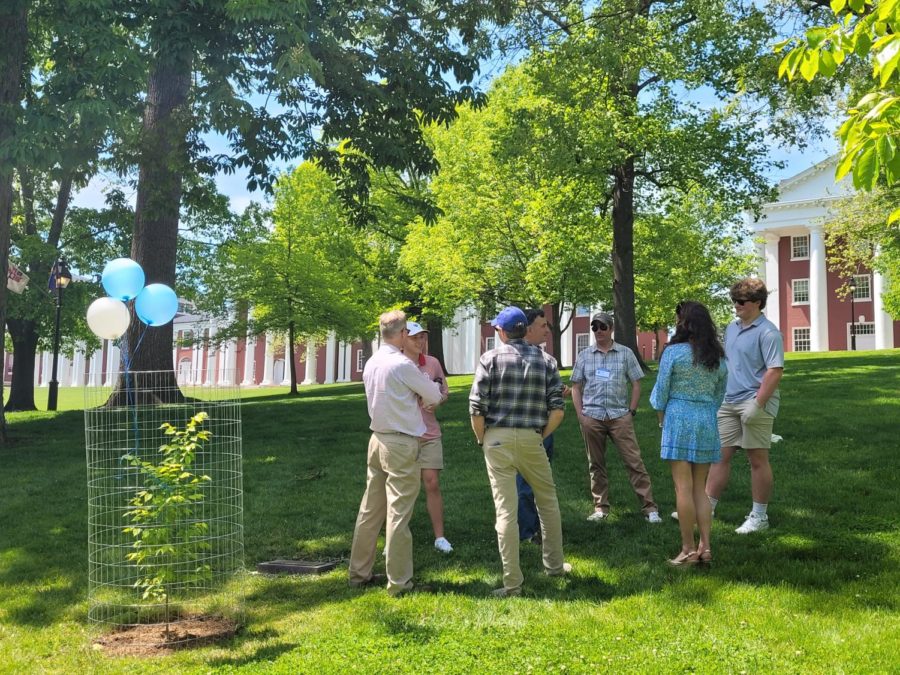W&L alum honors victims of Oklahoma City bombing, shares message of resilience
A planted sapling from the only tree to survive the bombing represents “the merging of two communities,” one student said
W&L students and alumni from Oklahoma gather by the Survivor Tree sapling after the dedication ceremony for the new campus memorial. Photo by Emma Malinak, ‘25
May 8, 2023
Russ Woody, ’98, was enjoying a relaxing morning in his room in Graham-Lees on April 19, 1995, when his friend sprinted through the halls to tell him that there had been a deadly explosion in his hometown of Oklahoma City.
Woody’s two younger siblings attended a high school 10 miles away from the explosion site. He spent the rest of the day glued to the news, watching to make sure his family was safe.
By midnight, Woody learned that his loved ones were not harmed in the explosion. But Woody said he, and every other Oklahoman, was shaken by the event that is now referred to as the Oklahoma City bombing.
“Even if you didn’t lose somebody, your life was changed,” he said.
On May 6, 2023, Woody honored the lives lost in the bombing and recognized Oklahoma City’s inspiring recovery by dedicating a memorial, consisting of a tree and a plaque, on Washington and Lee University’s campus.
“The bombing really did draw people together and give a renewed sense of civic pride, empathy and kindness to one another,” Woody said. “So this memorial is a statement about anti-terrorism, peace, prosperity, and resilience.”
The FBI calls the Oklahoma City bombing the “deadliest act of homegrown terrorism in the nation’s history.” A previous Army soldier and security guard named Timothy McVeigh parked a truck packed with explosives outside the Alfred P. Murrah Federal Building on the morning of April 19, 1995. The resulting explosion blew off the building’s north wall, killing 168 people, including 19 young children who were in the building’s daycare center.
More than 650 people were injured that day, and over 300 buildings in the area were damaged or destroyed.
In the midst of a city that looked like what the FBI described as a “war zone,” one American elm tree survived. The tree is now called “The Survivor Tree,” and it stands as the focal point of the city’s memorial that honors the lives lost in the bombing.
Woody’s current office in Oklahoma City overlooks the memorial, which he said reminds him of his community’s strength everyday. When the 25th anniversary of the attack passed in 2020, he said he wanted to find a way, as the president of the Oklahoma City chapter of alumni, to spread his city’s message of resilience to Washington and Lee.
Woody’s goal came to fruition this weekend when he unveiled a new memorial along Letcher Avenue next to University Chapel. The memorial includes a sapling of The Survivor Tree, which Woody said is the first to be planted in Virginia, and a plaque mounted on a piece of granite that was recovered from the Murrah building.
Shane Saunders, ’03, who grew up in Tulsa and was 14 when the bombing happened, said he remembers the “shock wave of emotion” that swept through the state in 1995. But he also recalled that he was impressed with how Oklahomans united to rebuild the city and care for victims of the attack.
“Everybody started pitching in. It’s what we now call the ‘Oklahoma Standard,’” Saunders said. “That’s our ethos. We take care of each other.”
The Oklahoma Standard refers to the mentality that was born from the effects of the Oklahoma City bombing. It encourages Oklahomans to live their lives “in response to the needs of their neighbors, fellow citizens, and communities,” according to the Oklahoma Standard website.
Ryan Schwartz, ’25, who calls Oklahoma City home, said he grew up hearing stories about how community members united to rebuild their city after the bombing. For him, the new memorial on campus is “a symbol of home.” The Oklahoma Standard connects his hometown’s culture to Washington and Lee’s atmosphere.
“Oklahoma has a very strong community, and a sense of that strong community is the same on this campus,” he said.
Ericka Shapard Croft, ’98, who was a student at Washington and Lee when her hometown of Oklahoma City was bombed, said that Oklahomans didn’t turn away from the challenges of recovering from the tragedy but rather embraced the opportunity to help one another.
“When the bombing in Oklahoma City happened, everybody ran towards it. Nobody ran away. I think that says a lot about the people in Oklahoma,” she said. “Even from horrible, tragic events, beauty can come.”
Because Woody was a student at Washington and Lee when the bombing happened, he said he couldn’t directly help his hometown recover. Today, almost 30 years after the tragedy, he said the tree and plaque are his ways of participating in the Oklahoma Standard.
“I had family and friends who volunteered for several months [after the bombing],” Woody said. “But I wasn’t there. That’s why it’s so important for me to have this memorial in Lexington.”
Woody said he hopes all students are reminded of the power of resilience when they walk by The Survivor Tree sapling. But for students from Oklahoma, he wants the memorial on the colonnade to have a deeper meaning.
“For Oklahomans who attend W&L, this is like a second home to us,” he said. “So to have a physical manifestation of that connection is important.”
Tucker Jacobsen, ’26, said the memorial connects his two homes.
“This is the merging of two communities,” he said. “You’re never that far from home. You can always have a piece of home wherever you are.”




